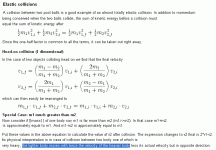In your train example the contact point of the tennis ball is elastic and the contact point of the train would be much less elastic( I think), however the tennis ball rebounds very fast. Is there a rebound speed relationship between the hardness or elasticity of both contact points? It seems to me that if a golf ball was substituted for the cue ball, the golf ball would rebound at a much higher speed than the cue ball.
The reason I ask that question leads to this question: will a tip which is very elastic (and hard) add speed to the cue ball?
By the way, your comments are respected and appreciated by the members of this forum.
